The renewal in January 2021 of a Memorandum of Understanding with Italy that will extend a blockade covering a full quarter century shows that enough is never enough for the opponents of lawful trade and the global circulation of art.

Italy and the Mediterranean taken by the Copernicus Sentinel-3A satellite. Photo by European Space Agency, 28 September 2016. CC BY-SA 3.0 IGO license
The new MOU just signed with Morocco is one of the final steps towards establishing a solid band of import restrictions around the eastern and southern Mediterranean from Italy through Greece, Bulgaria, Turkey,[i] Syria, Jordan, Egypt, Libya, Algeria, and Morocco. Tunisia has also requested an agreement that is likely already in the works.
Although the recent announcement regarding Morocco is one of the newest agreements signed, it’s worth noting that with a single exception (Canada), no agreement under the Cultural Property Implementation Act has ever been allowed to lapse after the five years set by law. They are always renewed. Nor have renewals ever significantly reduced the range of items covered. They are perpetual and virtually all-encompassing.
Whether this fact reflects the inefficacy of the agreements – that they don’t actually stop looting – or simply shows the Cultural Property Advisory Committee’s and State Department’s bias against the art trade and collecting museums – this pattern of actions is clear. It has become U.S. policy to impose and indefinitely continue blanket import restrictions regardless of whether or not the facts merit it and whether or not the requests for import restrictions actually meet the requirements set by Congress in the governing law, the 1983 Cultural Property Implementation Act.
ITALY
Several months after the October 29, 2020 signing of diplomatic notes regarding the renewal of the 2016 Memorandum of Understanding between the United States and the Italian Republic, it was announced that the Designated List for 2016 would remain the same. This announcement of the unchanged scope of Italian cultural property restrictions was published in the Federal Register on January 12, 2021. Maintaining the identical restrictions under the Designated List mean that a wide range of Italian artworks, paintings, sculptures, furnishings, tapestries, coins, manuscripts and more will continue to be blocked from entering the U.S.

Sandro Botticelli, Primavera, Uffizi Gallery, Florence. One of the best known paintings in the world.
On a positive note, it also means that the Cultural Property Advisory Committee did not expand coverage of the Italian MOU to include categories of Roman Republican or Roman Imperial coins, which was requested by the archaeological lobby but opposed by U.S. businesses. Since restricted items are required to be “first discovered” in the country requesting the MOU, and since only 2.8% of the coins found in an Oxford University study of Roman world coin hoards were found within the borders of modern Italy, it is extremely unlikely that Roman Imperial coins now in circulation originated in Italy.[ii] (For details, see a thorough analysis of the minting and distribution of Roman Imperial and other coins discussed in IAPN Submission 2020 Hearing on Italian MOU Renewal.)
The Committee for Cultural Policy, which publishes Cultural Property News, provided extensive testimony on the renewal of the Italian MOU at the State Department in July 2020. That testimony is available here in full.
The 2016 restrictions on the importation of categories of archaeological material from Italy will continue in effect until January 12, 2026 unless an interim review of the MOU at the Cultural Property Advisory Committee determines that Italy’s request no longer meets the requirements set forth under the Cultural Property Implementation Act. In the last twenty years, during which the Italian MOU has been in place, a thorough interim review does not appear to ever have taken place, so it is not likely that there will be one in the future.
Is this MOU necessary to halt looting after 20 years?
The October 2020 exchange of diplomatic notes on the MOU in the Italian Embassy in Washington DC included a display of several artifacts recovered by the FBI: a bust dating back to the 1st century BCE, stolen from Villa Torlonia in the 1980s, two manuscripts dating to the 9th century CE, and a Roman coin. These appear to have been stolen items, not looted objects from archaeological sites. Stolen objects are, of course, recoverable at any time under U.S. law. An MOU is not required for this purpose. Where is the evidence that the U.S. is a hotbed of illegal sales of Italian art?

Lire 100.000 (Botticelli), photo by OneArmedMan, Wikimedia Commons
MOUs are intended to deter looting and countries’ requests are supposed to demonstrate that current looting is a serious threat to all the art and artifacts on the Designated List. Italy has not demonstrated this. In fact, over the last twenty years, Italy’s Carabinieri have greatly enhanced suppression of looting and made it a largely unprofitable exercise. The art and antiquities markets have also changed significantly in the last decades. Legitimate art and coin dealers now reject unprovenanced, looted materials and have adopted due diligence measures.
US museums and art collectors have been severely restricted in acquisitions from Italy for twenty years. They will now continue to face an embargo that also applies to legitimate sales of Italian art and coins from other EU nations. Thousands of small US businesses will continue to suffer economic harm from this unfair restriction applying in the U.S. but not in Europe. Once again, the MOU fails to require Italy to engage positively with U.S. museums by making long term loans of Italian artworks on reasonable terms. This is another huge loss to the American public’s access to a history that is full of meaning for so many of our people.
The MOU also fails to require a commitment from Italy to work toward establishing a lawful, permitted trade. A legal market, overseen by the Italian government, would allow for the supervised sale and purchase of redundant archeological and other works of art. This would be of significant benefit to both the US and Italian public, supporting the underlying principle of the benefits of cultural exchange. U.S. museums and the art trade have sought such a solution for 20 years. Italy has done nothing to forward it.
Without measurable goals and data for review of past agreements, which Italy has failed to provide since the Italian MOU first came into force in 2001, U.S. stakeholders including museums and academic institutions will be left without the necessary tools to incentivize mutually rewarding cultural exchange.
U.S. policy set by Congress clearly maintains a preference for the free movement of art. The Italian renewal means that this policy has been set aside – despite the lack of evidence that an art blockade with Italy is either necessary or beneficial for the American public.
MOROCCO
On January 14, 2021, the U.S. and the government of Morocco signed a bilateral agreement restricting antiquities from one million BCE (!) to 1750 CE and ethnological materials from 1549 CE to 1912 from importation into the U.S. unless accompanied by documentation of lawful export from Morocco.
Since other agreements have now been extended for over a quarter century, it is not unreasonable to wonder if in 2040 or 2045 the Committee will still be debating the need to ‘protect’ Moroccan cultural heritage that ranges from one million BC to the twentieth century and to include commodities as unlikely to present a looting threat as ancient “rope,” which is listed as a prohibited item on the Final Rule (aka Designated List) issued by U.S. Customs and Border Protection.

Old American Legation Museum, Tangier, Morocco, photo by Diego Delso, diego.delso, 11 December 2015, license CC BY-SA. Wikimedia Commons.
The Committee for Cultural Policy and Global Heritage Alliance submitted joint written testimony on the proposed Moroccan MOU. It was necessarily lengthy (though not lengthy enough to include testimony on rope – our mistake!), as the Government of Morocco and State Department did not provide a copy or even a summary of the request and the reasons for it before the end of the public comment period. The public comment period allowed after announcement of the proposed Moroccan MOU was also only two weeks long and included a federal holiday and the Jewish High Holiday of Yom Kippur.
(This was surprising, since the State Department had previously assured the U.S. Jewish community that it would not fail again to provide adequate time for public comment after having an even shorter period for comment on the Libyan MOU. In addition, since the Libyan debacle, eighteen prominent Jewish organizations had raised concerns about overbroad cultural property agreements giving MENA governments rights to Jewish heritage in a December 8, 2018 letter to Secretary of State Mike Pompeo. Museum organizations had also told the State Department that they could not canvas their members regarding MOUs in so short a time.)
Interestingly, although staff at the Bureau of Educational Cultural Affairs, which manages the Cultural Property Advisory Committee, had previously informed representatives of Jewish groups that it was not possible to carve out items based upon the religious affiliation of their original owners, this is exactly what they have done in the Moroccan MOU.
The Jewish items excluded from the Moroccan Final Rule, and therefore able to be imported, are limited to “Jewish ceremonial or ritual objects” dating from “the Saadian and Alaouite dynasties ranging in date from approximately A.D. 1549 to 1912.” Jewish-owned antique items of stone, ceramic, metal or wood, vessels and other items presumably would fall into general ethnographic categories and would be included in the import ban.

Jewish Cemetery, Tangier, Morocco. Photo by Diego Delso. 11 December 2015. CC-by-SA. Wikimedia Commons.
It is unknown whether or not this exclusion will be repeated in other MOUs, since Morocco has relatively positive relations with Jewish communities there and in the diaspora, and may have been more amenable to the carve-out than other MENA countries. For example, Torahs and Hebrew manuscripts are listed in the Designated Lists for Syria, Iraq and Egypt and if imported must be returned to those governments, despite their Jewish populations having been driven out and forced to leave their possessions behind.
The Final Rule/Designated List for Morocco also takes a strange approach in its description of the material culture of Morocco’s Muslim population. It repeatedly identifies objects as being used for “religious purposes” when they seem to apply to ordinary objects. It is common in Islamic cultures to ornament objects with an inscription, both for decoration and good feeling.
The list appears to include anything with an inscription as “religious” or “ceremonial” despite the fact that quotes from the Quran (together with homilies and homely sayings) are the most common decorative program for handmade objects in wood, copper, and stone. Objects, even Quran holders are rarely “ceremonial” and they are certainly not “religious.”
That comes close to idolatry, which is strictly forbidden in Islam. It’s also rather like calling the embroidered decorations many Americans have that say “God Bless our Home as “ceremonial” and “religious” objects of our culture.
The list of ceremonial objects even includes prayer beads, which are the most ubiquitous and common possession possible (except clothing). On the Designated List, seal rings of any quality – which non-literate people use to sign their names on documents, have suddenly become “ceremonial” by virtue of being inscribed with a quotation from the Quran. The list also includes “Musical Instruments—This category includes instruments used in Islamic/Sufi religious ceremonies or rituals, such as frame drums (banadir).” All fine and good, but dancers as well as Sufis use frame drums.
Whether or not this is material, it creates ambiguity and will certainly serve to confuse U.S. Customs, which will be expected to distinguish between what is and isn’t “Ceremonial Paraphernalia – This category includes boxes, reliquaries (and their contents), plaques, pendants, candelabra, and stamp and seal rings.” Reliquaries? Wrong religion.
Rugs and textiles not included.

Antique carpet shop, Morocco, photo by Safaa2606, 28 June 2018, Creative Commons Attribution-Share Alike 4.0 International license.
The many U.S. businesses that trade in oriental rugs and textiles will be glad to see that Moroccan rugs and textiles are not included in the Designated List. Since the list covers ‘ethnographic’ objects up to 1912, carpet dealers in the U.S., who have been selling Moroccan antiques as well as a vast number of newer rugs would have had an impossible time trying to distinguish between a 1911 rug and one from 1913. The fact is, these (and so many other common antiques that, unfortunately, are on the Designated List) were made for trade, especially export trade, for hundreds of years.
Congress never intended that the term ‘ethnographic’ refer to ordinary household objects, and the items restricted were only intended to cover “products of a tribal or non-industrial society,”[iii] not objects made for sale within a thriving Mediterranean civilization.
Coins, even some Spanish coins are now Moroccan heritage.
There are also very broad restrictions on coins that include Roman Republic and Imperial coins not even listed on Italy’s Designated List. The majority of the coin types listed as Moroccan heritage did not circulate primarily in Morocco and therefore there is little reason for U.S. Customs authorities to think that they were originally found there, as the law requires. These include coins of Numidian, Mauritanian, Greek/Punic, Roman, Byzantine, Islamic, and Medieval Spanish types.
Coin specialist Peter K. Tompa of Global Heritage Alliance has noted that, “Oddly, Spanish coins are also mentioned, though Spain occupies two ports, Ceuta and Melilla on the Moroccan coast. Portugal first captured Ceuta in 1415. Spanish rule began in 1581 when the Portuguese kingdom merged with the Spanish Kingdom. Melilla has been Spanish since 1497. Perhaps, the Moroccans wish the Spanish were not there, but to recognize Moroccan rights to claim Spanish coins can only be viewed as the State Department Cultural Heritage Center and U.S. Customs treading in areas that should be reserved for other parts of the U.S. State Department.”
Additional reading:
Morocco Seeks US Import Restrictions on Ancient & Ethnic Art: At CPAC Hearing, Both Time and Facts are Scarce. Cultural Property News, October 29, 2019.
Italy Wants 20 Year Art Blockade Expanded to 2025: CCP Testifies Against Import Ban on Ancient Art Legally Sold in Italy, Cultural Property News, July 8, 2020
CPAC – Building a Wall Against Art, Cultural Property News, June 28, 2018
[i] An agreement was signed January 19, 2021 but the Final Rule/Designated List has not been published as of this writing.
[ii] A pertinent passage from the submission of the International Association of Professional Numismatists on the renewal of the Italian MOU, written by attorney and coin expert Peter K. Tompa states: “Such coins were never intended to circulate only within the confines of modern-day Italian nation state. Indeed, a search of the Ashmolean Museum’s online database of Coin Hoards of the Roman Empire (http://chre.ashmus.ox.ac.uk/hoard/) reveals that of the 2,199 hoards mapped in CHRE, only 62 (2.8%) containing coins from Roman Imperial Mints located in Italy were found within the borders of the modern Republic of Italy. This would make any restrictions imposed upon them solely predicated on where they were made or are sometimes found completely contrary to the CPIA’s statutory intent. Ancient Coin Collectors Guild v. U.S. Customs and Border Protection (“ACCG v. CBP”), 801 F. Supp. 2d 383, 407 n. 25 (D. Md. 2011) (“Congress only authorized the imposition of import restrictions on objects that were ‘first discovered within, and [are] subject to the export control by the State Party.”).
[iii] 19 C.F.R. §12.104(a)(2)(i)
 Giotto di Bondone, cycle of frescoes in the Scrovegni Chapel Padua, Province of Padua, Region of Veneto, Italy, completed about 1305, Photo by Zairon, 30 September 2017, Creative Commons Attribution-Share Alike 4.0 International license.
Giotto di Bondone, cycle of frescoes in the Scrovegni Chapel Padua, Province of Padua, Region of Veneto, Italy, completed about 1305, Photo by Zairon, 30 September 2017, Creative Commons Attribution-Share Alike 4.0 International license. 

